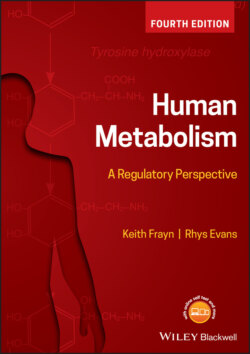Читать книгу Human Metabolism - Keith N. Frayn - Страница 43
1.3.3.3 Fatty acid oxidation
ОглавлениеFollowing uptake into cells, fatty acids are rapidly ‘activated’ by esterification to CoA, forming fatty acyl-CoA; this esterification (known as thio- esterification because of the –SH thio group of the CoA molecule) also removes the amphipathic, detergent-like character of the fatty acid, making it less toxic in the membrane-rich cytosol. This reaction requires ATP and releases inorganic pyrophosphate, PPi. PPi is rapidly broken down to Pi, meaning that this step is essentially irreversible. It therefore achieves the same end as glucose phosphorylation to glucose 6-phosphate on entering a cell: it both traps the fatty acid within the cell, and creates a concentration gradient to draw more fatty acids into the cell. The enzymes concerned are known as acyl-CoA synthases (ACSs): again there is a family of these, suited for fatty acids of different carbon chain lengths. The action of the ACSs may be intimately linked to the process of fatty acid transport into the cell, discussed further in Chapter 2.
The fatty acyl moiety may then undergo β-oxidation to yield acetyl-CoA (together with NADH and FADH2) for further oxidation and ATP formation (Figure 1.16 and Box 1.7). This process occurs in mitochondria (hence cells lacking this organelle, such as red blood cells, are unable to derive energy from fatty acids because they cannot oxidise substrates). However, in order to get inside the mitochondria, the fatty acyl-CoA must cross the IMM on the carnitine shuttle (Box 1.7), and it is the activity of the carnitine shuttle that regulates the rate of supply of fatty acids to the mitochondria, and hence of the rate of β-oxidation.
